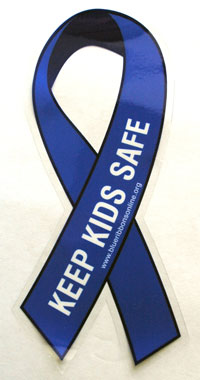National Child Abuse and Neglect Prevention Month - April
+2
TigerMom
Piper
6 posters
Page 1 of 1
 National Child Abuse and Neglect Prevention Month - April
National Child Abuse and Neglect Prevention Month - April
What is the Blue Ribbon Campaign?

In the spring of 1989, a Virginia grandmother began the Blue Ribbon Campaign as a tribute to her grandson. The 3-year-old died at the hands of his mother’s abusive boyfriend. The Blue Ribbon Campaign is a memorial to children who have been touched by abuse and neglect, and a reminder that everyone has a job to do to prevent the maltreatment of children.
What does the blue ribbon symbolize?
The blue ribbon is a positive symbol of the need to do one’s best when it comes to children and families. Since 1989, thousands of people nationwide wear the blue ribbon during April—National Child Abuse and Neglect Prevention Month—and year round to create awareness of the need to prevent child abuse and neglect.
Why is child abuse prevention so important?
Child abuse can happen in any home, in any neighborhood, within any family. According to statistics form the U.S. Department of Health and Human Services, reporting agencies nationwide received 2.9 million referrals for child abuse and neglect in 2003, and an estimated 1,500 children died from maltreatment.
Abused and neglected children do poorly in school, are more likely to become teen parents, and abuse alcohol and drugs. They are more likely to become criminals as adults and to suffer chronic health problems. Most children who are abused bear psychological scars—and in some cases, physical scars—forever.
What can I do to help prevent child abuse?
Becoming involved in the Blue Ribbons for Kids campaign is a good place to start. Building positive parenting skills and improving community support for families also are effective ways to prevent child abuse and neglect.
Since 1989, millions of people across the country have participated in the Blue Ribbon Campaign by wearing and distributing blue ribbons and organizing community activities that help keep kids safe and families strong.

In the spring of 1989, a Virginia grandmother began the Blue Ribbon Campaign as a tribute to her grandson. The 3-year-old died at the hands of his mother’s abusive boyfriend. The Blue Ribbon Campaign is a memorial to children who have been touched by abuse and neglect, and a reminder that everyone has a job to do to prevent the maltreatment of children.
What does the blue ribbon symbolize?
The blue ribbon is a positive symbol of the need to do one’s best when it comes to children and families. Since 1989, thousands of people nationwide wear the blue ribbon during April—National Child Abuse and Neglect Prevention Month—and year round to create awareness of the need to prevent child abuse and neglect.
Why is child abuse prevention so important?
Child abuse can happen in any home, in any neighborhood, within any family. According to statistics form the U.S. Department of Health and Human Services, reporting agencies nationwide received 2.9 million referrals for child abuse and neglect in 2003, and an estimated 1,500 children died from maltreatment.
Abused and neglected children do poorly in school, are more likely to become teen parents, and abuse alcohol and drugs. They are more likely to become criminals as adults and to suffer chronic health problems. Most children who are abused bear psychological scars—and in some cases, physical scars—forever.
What can I do to help prevent child abuse?
Becoming involved in the Blue Ribbons for Kids campaign is a good place to start. Building positive parenting skills and improving community support for families also are effective ways to prevent child abuse and neglect.
Since 1989, millions of people across the country have participated in the Blue Ribbon Campaign by wearing and distributing blue ribbons and organizing community activities that help keep kids safe and families strong.








